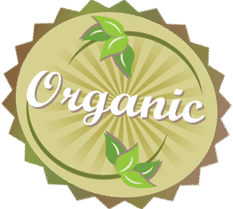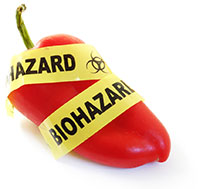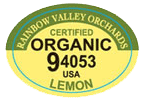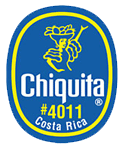Organic Living
Does buying organic food really make a difference?
Is it worth it to invest in organic food for your family?
ABSOLUTELY!

Organically grown food is defined as food grown without pesticides, artificial fertilizers, hormones, antibiotics, or genetic modification. The food colorings, flavorings, and preservatives in organic foods are all derived from natural sources.
Organic foods are hands down healthier than their non-organic counterparts. Not only are they grown without harmful chemicals, but they are also more nutritious. Organic products are the fastest growing part of the food industry in the United States.(1)
Benefits of Going Organic
|
There are many important reasons to choose organic foods:
- The very serious health dangers of ingesting pesticidal residue, especially to infants and the growing fetus. ...Read the studies
- Studies show organic foods are hands down nutrient dense.
- Organic foods are more flavorful.
- Organic farming works with the land, rather than destroys it.
- Washing produce with water does NOT remove pesticidal residue.
- Conventional animal farming promotes cruel and inhumane practices.
Learn why the organic choice is such an important one, not only for your health and the health of your family, but also for the health of the environment and the animals on factory farms.
The benefits of going organic...
Why Does Non-Organic Produce Sometimes Look Better?
 When we go to the grocery store, we may be automatically drawn to non-organic produce that is ripe, spotless, huge, and which look perfectly flawless. Some people avoid organic produce because it does not look as "pretty" as non-organic produce. Nor does it bruise as easily, and it lasts longer. But there are reasons for this unnatural perfection, and they aren't good ones:
When we go to the grocery store, we may be automatically drawn to non-organic produce that is ripe, spotless, huge, and which look perfectly flawless. Some people avoid organic produce because it does not look as "pretty" as non-organic produce. Nor does it bruise as easily, and it lasts longer. But there are reasons for this unnatural perfection, and they aren't good ones:
- Some conventionally grown food items contain food dyes to make them look more appealing.
- Tomatoes are ripened with ethylene gas.
- The size of produce is artificially increased, which is both unnatural and also reduces the flavor of the entire food.
- Pesticides prevent marks from bugs, but come at a great expense to not only our health, but also at the expense of the farm workers who wade through the fields that are soaked with pesticides to collect our produce for us.
The food industry does not want you to know the truth about what you are eating, simply because you may not eat it. A veil is created where all you are shown is the attractive "end-product" as a result of unnatural farming practices and the chemicalization of our food chain.
Switching To Organic - Can I Afford It?
Making the switch to 100% organic is tough for some families who either do not want to pay higher prices, or who are concerned about giving up their favorite foods. Many of us cannot afford to buy all organic fruits and vegetables all the time. It can be expensive!
But by making the switch to organic versions of just a few foods that you often eat (especially the worst offenders when it comes to heavy pesticides), you can make a significant difference to the pesticides you and your family ingest, without a big impact on your budget.
Here are some helpful tips on saving money with organics:
- Be strategic in your organic purchases. There are specific fruits and vegetables that contain much higher amounts of pesticide residue than others. For example, broccoli, asparagus and onions have lower levels of chemicals than strawberries, apples, and cherries. Choose organic produce for the worst offenders, and non-organic for the ones that contain less pesticides. The most vs. least pesticide-ridden produce
- Spray your conventional produce with distilled white vinegar before eating it. Simply purchase a spray bottle, fill it with vinegar, and keep it next to (or under) your sink. Industrial chemicals such as pesticides are built to withstand rinsing with water, but not vinegar which helps neutralize the toxins on the outer skins.
- Buy organic produce that is on sale - there are always specials on organic produce at the large grocery and health food stores. Sometimes, organic produce can be the same price, if not cheaper, than conventional produce even when it is not on sale.
- Check out the local farmers markets and farms for your produce, and especially for eggs from pasture-raised chickens and raw cheese and dairy products. These products are often cheaper than the ones in the store. If you need help finding local growers and organic markets, check out Local Harvest to search for nearby sources of organic food, or ask around at nearby natural health food stores.
- Buy organic, pasture-raised meats close to expiration (when on sale) and cook them immediately. They are often cheaper than their non-organic counterparts. This is what we do for our pooch to mix in with her meals.
Look For Local Foods - Here's Why
Purchasing fruits and vegetables from local farms means that you are purchasing the freshest produce possible. In virtually every city and rural community, there are either local farmers markets or farms that sell produce and other foods ranging from fruits and vegetables, to honey, dairy, and pasture-raised meats. Some are open during the spring, summer, and fall, and others are open all year around.
But it is more than simply buying fresher food and supporting local farmers. The energy required to make our food, including shipping it, driving it, flying it, refrigerating it, and processing it, requires over 100 billion gallons of oil per year. Food processing itself consumes 16% of the energy used to make food, and can actually use up more energy than the food itself produces when we eat it.
Let's see how:
- Processing a box of cereal takes 7,000 kilocalories to manufacture and distribute, but you only get 1,100 kilocalories from eating the entire box of cereal.
- Agriculture is directly responsible for approximately 18% of greenhouse gas emissions.
- Because food imports are surging, the average American prepared meal contains 5 ingredients, each from different countries.
- The food we eat at each meal travels an average of 1,500 miles and was in transit 7-14 days.
- To survive an average of 1,500 miles on the road, conventionally grown produce may have added contaminants to make them last longer. For example, tomatoes are picked when hard and green, then gassed with ethylene to forcibly ripen them.
The produce from Community Supported Agriculture (CSA) costs less than half what the same produce would cost if it was purchased in a grocery store. Local food is not only fresher and cheaper, it also saves a significant amount of energy and resources!
| Organic vs. Certified Organic. What's the Difference? Many farmers use no pesticides and grow organic produce, but they are not certified to be USDA organic, which means they cannot use the "Certified USDA" stamp. This certification is a very expensive process and many small farmers simply cannot afford it. But this does not mean that they do not follow the same practices. It can be difficult to verify, but if the farm is local and you are welcomed for a visit, check out their facility and make an educated decision based on your observations, and their approach to sustainable farming practices. |
Recognizing Organic Produce in Stores
In supermarket chains and health food stores, one way to recognize organic products is by how clearly the store arranges their food. Many stores now contain a natural food section where they store the organic and GMO-free food. When it comes to fresh produce, take a look at the product PLU code (short for "price look-up code"), which is either on the label wrapped around the produce, or on a sticker attached to it.
 Organically grown produce
Organically grown produce
5-digit PLU code beginning with 9 (e.g. Lemon - 94053)- Conventionally grown produce
 4-digit PLU code beginning with 3 or 4 (e.g. Banana - 4011)
4-digit PLU code beginning with 3 or 4 (e.g. Banana - 4011) - Genetically modified produce (GMOs)
5-digit PLU code beginning with 8 (see below)
Unfortunately, there is no federal mandate in the US requiring that food be labeled as genetically modified, therefore the 5 digit code that begins with an 8 is rare to find. Many Americans say they would avoid GMOs if they were labeled, therefore many seed companies do not even want farmers to know which of their seeds are genetically modified. This means the public will find it almost impossible to distinguish GMOs from non-GMOs unless the food is organic - another reason to purchase organic! (either that, or move to one of the 64 other countries that DO label their products as GMOs).
Organic Foods & Heavy Metals
Currently, the USDA organic standards place no limits on heavy metal contamination in certified organic foods. This means that organic products can contain various heavy metals, including mercury, lead, cadmium, arsenic, and aluminum. There is also also no limit on the contamination of PCBs, BPAs, and other synthetic chemicals that are allowed in certified organic foods and supplements.
RELATED ARTICLES
- Benefits of going organic
- Buying produce: Food with the most vs. least pesticides
- A fun experiment!
- Biodynamic farming
- The toxic nature of household cleaners
- Serious health dangers of pesticides in food
- Pesticides in our home & garden
- 7 dangers of eating factory-farmed meat
- Eat meat responsibly & purchase meat wisely
- Why many people are avoiding factory-farmed meat
- The truth about the seafood industry
- The environmental impact of factory farming
- What GMOs are & why you should avoid them
- Building a natural, non-toxic cleaning cabinet



